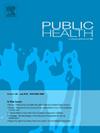Pregnancy loss <28 weeks gestation in maternal influenza and COVID-19 vaccination studies: a review of data sources, 2009–2024
IF 3.9
3区 医学
Q1 PUBLIC, ENVIRONMENTAL & OCCUPATIONAL HEALTH
引用次数: 0
Abstract
Objectives
To address gaps in maternal vaccination and pregnancy loss research, large, complex datasets are needed. We aimed to identify and evaluate data sources and data collection methods currently used to capture pregnancy losses <28 weeks following maternal influenza and COVID-19 vaccination research.
Study design
Narrative Review.
Methods
PubMed, CINAHL, Scopus, and Web of Science were used to identify studies that investigated pregnancy loss <28 gestational weeks following influenza and COVID-19 vaccinations from January 1st, 2009, to March 19th, 2024. Within the resulting studies, the data source(s) used to capture exposure and outcome data were identified and categorised. The capacity to capture and measure exposures, outcomes, and missing data within categories was investigated.
Results
28 articles met the inclusion criteria, representing 1,113,878 participants. Most articles (n = 19) used multiple data sources within the one study, often obtaining exposure and outcome data from separate data sources. Categories of data sources included: registries, adverse reporting systems, medical records, and survey or interview methods.
Conclusion
Current data collection practices and existing data sources are adversely impacting data quality, and the ability to combine large datasets necessary for analysing early pregnancy loss risk factors. This also hinders our ability to evaluate the safety of early maternal vaccination and subsequent miscarriage. Establishing pregnancy loss registries using standardised data collection and coding practices, consistent terminology, and accurate exposure and outcome timing is critical. In the absence of registries, we propose an alternative source to capture both pregnancy loss and maternal vaccination data.
孕妇流感和COVID-19疫苗接种研究中妊娠损失<28周:2009-2024年数据来源综述
目的为了解决孕产妇疫苗接种和妊娠丢失研究的空白,需要大型、复杂的数据集。我们的目的是确定和评估目前用于记录孕妇流感和COVID-19疫苗接种研究后28周妊娠损失的数据来源和数据收集方法。研究设计:叙述性回顾。方法采用spubmed、CINAHL、Scopus和Web of Science对2009年1月1日至2024年3月19日期间流感和COVID-19疫苗接种后28孕周的妊娠损失进行研究。在由此产生的研究中,确定并分类了用于捕获暴露和结果数据的数据源。调查了捕获和测量类别内暴露、结果和缺失数据的能力。结果28篇文章符合纳入标准,共纳入1113878名受试者。大多数文章(n = 19)在一项研究中使用了多个数据源,通常从不同的数据源获得暴露和结局数据。数据来源类别包括:登记、不良报告系统、医疗记录以及调查或访谈方法。结论当前的数据收集实践和现有的数据来源对数据质量产生不利影响,影响了分析早期妊娠丢失风险因素所需的大型数据集的整合能力。这也妨碍了我们评估早期产妇接种疫苗和随后流产的安全性。使用标准化的数据收集和编码实践、一致的术语以及准确的暴露和结果时机建立妊娠损失登记至关重要。在缺乏登记的情况下,我们提出了一种替代来源来获取妊娠损失和孕产妇疫苗接种数据。
本文章由计算机程序翻译,如有差异,请以英文原文为准。
求助全文
约1分钟内获得全文
求助全文
来源期刊

Public Health
医学-公共卫生、环境卫生与职业卫生
CiteScore
7.60
自引率
0.00%
发文量
280
审稿时长
37 days
期刊介绍:
Public Health is an international, multidisciplinary peer-reviewed journal. It publishes original papers, reviews and short reports on all aspects of the science, philosophy, and practice of public health.
 求助内容:
求助内容: 应助结果提醒方式:
应助结果提醒方式:


